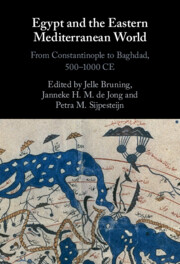Book contents
- Egypt and the Eastern Mediterranean World
- Egypt and the Eastern Mediterranean World
- Copyright page
- Contents
- Figures, Graphs, and Tables
- Notes on Contributors
- Notes on Transliteration, Names, and Dates
- Preface and Acknowledgments
- Additional material
- Introduction
- Part I Political and Administrative Connections
- Part II Economic Connections
- Part III Social and Cultural Connections
- Chapter 10 The Destruction of Alexandria: Religious Imagery and Local Identity in Early Islamic Egypt
- Chapter 11 Scribal Networks, Taxation, and the Role of Coptic in Marwanid Egypt
- Chapter 12 A Changing Position of Greek? Greek Papyri in the Documentary Culture of Early Islamic Egypt
- Chapter 13 Regional Diversity in the Use of Administrative Loanwords in Early Islamic Arabic Documentary Sources (632–800 CE): A Preliminary Survey
- Chapter 14 Babylon/Qaṣr al-Shamʿ: Continuity and Change at the Heart of the New Metropolis of Fusṭāṭ
- Chapter 15 Utilizing Non-Muslim Literary Sources for the Study of Egypt, 500–1000 CE
- Index
- References
Chapter 11 - Scribal Networks, Taxation, and the Role of Coptic in Marwanid Egypt
from Part III - Social and Cultural Connections
Published online by Cambridge University Press: 01 December 2022
- Egypt and the Eastern Mediterranean World
- Egypt and the Eastern Mediterranean World
- Copyright page
- Contents
- Figures, Graphs, and Tables
- Notes on Contributors
- Notes on Transliteration, Names, and Dates
- Preface and Acknowledgments
- Additional material
- Introduction
- Part I Political and Administrative Connections
- Part II Economic Connections
- Part III Social and Cultural Connections
- Chapter 10 The Destruction of Alexandria: Religious Imagery and Local Identity in Early Islamic Egypt
- Chapter 11 Scribal Networks, Taxation, and the Role of Coptic in Marwanid Egypt
- Chapter 12 A Changing Position of Greek? Greek Papyri in the Documentary Culture of Early Islamic Egypt
- Chapter 13 Regional Diversity in the Use of Administrative Loanwords in Early Islamic Arabic Documentary Sources (632–800 CE): A Preliminary Survey
- Chapter 14 Babylon/Qaṣr al-Shamʿ: Continuity and Change at the Heart of the New Metropolis of Fusṭāṭ
- Chapter 15 Utilizing Non-Muslim Literary Sources for the Study of Egypt, 500–1000 CE
- Index
- References
Summary
After the Arab conquest of 639–42 CE Egypt became part of the burgeoning Islamic empire. Over the course of the seventh and eighth centuries a series of measures was introduced by the new rulers. They established a dīwān in Egypt’s new capital, Fusṭāṭ, a postal service, a system of corvées targeted toward equipping the navy and providing labor for major construction projects, and a new religious poll tax payable by all adult non-Muslim men. This period is characterized by increasing Arabization (the use of Arabic) and Islamization (the appointment of Muslim officials throughout the country, replacing local officials).1 The wealth of the surviving textual sources from Egypt – in Arabic (the language of the new rulers), Greek (the administrative and legal language of the previous regime, as well as that of a considerable number of the population), and Coptic (the indigenous language) – is unrivaled and allows us to examine language use in the country after the conquest in a way that is not possible for other provinces in the empire.
- Type
- Chapter
- Information
- Egypt and the Eastern Mediterranean WorldFrom Constantinople to Baghdad, 500-1000 CE, pp. 353 - 378Publisher: Cambridge University PressPrint publication year: 2022



